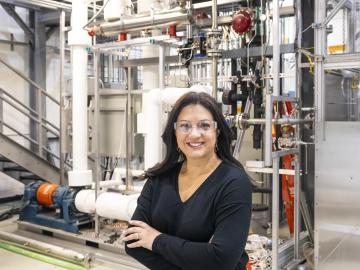
Filter News
Area of Research
- Advanced Manufacturing (3)
- Biology and Environment (17)
- Building Technologies (1)
- Computational Biology (1)
- Computational Engineering (2)
- Computer Science (4)
- Electricity and Smart Grid (1)
- Energy Science (30)
- Fusion and Fission (6)
- Fusion Energy (1)
- Isotopes (4)
- Materials (3)
- Materials for Computing (5)
- Mathematics (1)
- National Security (2)
- Neutron Science (6)
- Nuclear Science and Technology (1)
- Quantum information Science (2)
- Sensors and Controls (1)
- Supercomputing (15)
News Topics
- (-) Biomedical (10)
- (-) Clean Water (8)
- (-) Computer Science (30)
- (-) Grid (10)
- (-) Machine Learning (1)
- (-) Nuclear Energy (6)
- (-) Space Exploration (4)
- 3-D Printing/Advanced Manufacturing (26)
- Advanced Reactors (2)
- Artificial Intelligence (7)
- Big Data (5)
- Bioenergy (13)
- Biology (23)
- Biotechnology (5)
- Buildings (13)
- Chemical Sciences (7)
- Composites (6)
- Coronavirus (10)
- Critical Materials (4)
- Cybersecurity (5)
- Energy Storage (21)
- Environment (39)
- Exascale Computing (2)
- Frontier (4)
- Fusion (8)
- High-Performance Computing (19)
- Isotopes (12)
- ITER (4)
- Materials (32)
- Materials Science (22)
- Mathematics (1)
- Mercury (3)
- Microscopy (10)
- Nanotechnology (10)
- National Security (7)
- Neutron Science (20)
- Physics (3)
- Polymers (5)
- Quantum Computing (5)
- Quantum Science (12)
- Security (3)
- Statistics (1)
- Summit (9)
- Transportation (21)
Media Contacts

Toward the goal of bringing the next generation of nuclear power reactor technology online this decade, ORNL and Analysis and Measurement Services Corporation have successfully completed loop testing of instrument and control sensors for an advanced reactor design for small modular reactors.

The U.S. Department of Energy’s Innovative and Novel Computational Impact on Theory and Experiment, or INCITE, program is seeking proposals for high-impact, computationally intensive research campaigns in a broad array of science, engineering and computer science domains.

Rich Giannone uses bioanalytical mass spectrometry to examine proteins, the primary driver in biological systems.

Using complementary computing calculations and neutron scattering techniques, researchers from the Department of Energy’s Oak Ridge and Lawrence Berkeley national laboratories and the University of California, Berkeley, discovered the existence of an elusive type of spin dynamics in a quantum mechanical system.

The Accelerating Therapeutics for Opportunities in Medicine , or ATOM, consortium today announced the U.S. Department of Energy’s Oak Ridge, Argonne and Brookhaven national laboratories are joining the consortium to further develop ATOM’s artificial intelligence, or AI-driven, drug discovery platform.

A rare isotope in high demand for treating cancer is now more available to pharmaceutical companies developing and testing new drugs.

Scientists have found new, unexpected behaviors when SARS-CoV-2 – the virus that causes COVID-19 – encounters drugs known as inhibitors, which bind to certain components of the virus and block its ability to reproduce.

Researchers at Oak Ridge National Laboratory have identified a statistical relationship between the growth of cities and the spread of paved surfaces like roads and sidewalks. These impervious surfaces impede the flow of water into the ground, affecting the water cycle and, by extension, the climate.

Researchers at the Department of Energy’s Oak Ridge National Laboratory and the University of Tennessee are automating the search for new materials to advance solar energy technologies.

Xin Sun has been selected as the associate laboratory director for the Energy Science and Technology Directorate, or ESTD, at the Department of Energy’s Oak Ridge National Laboratory.


